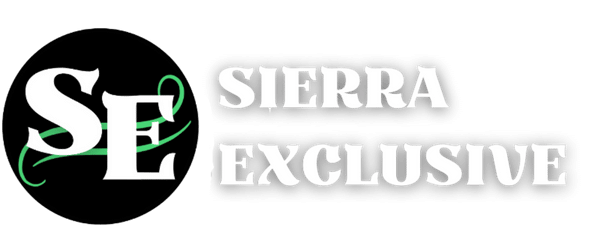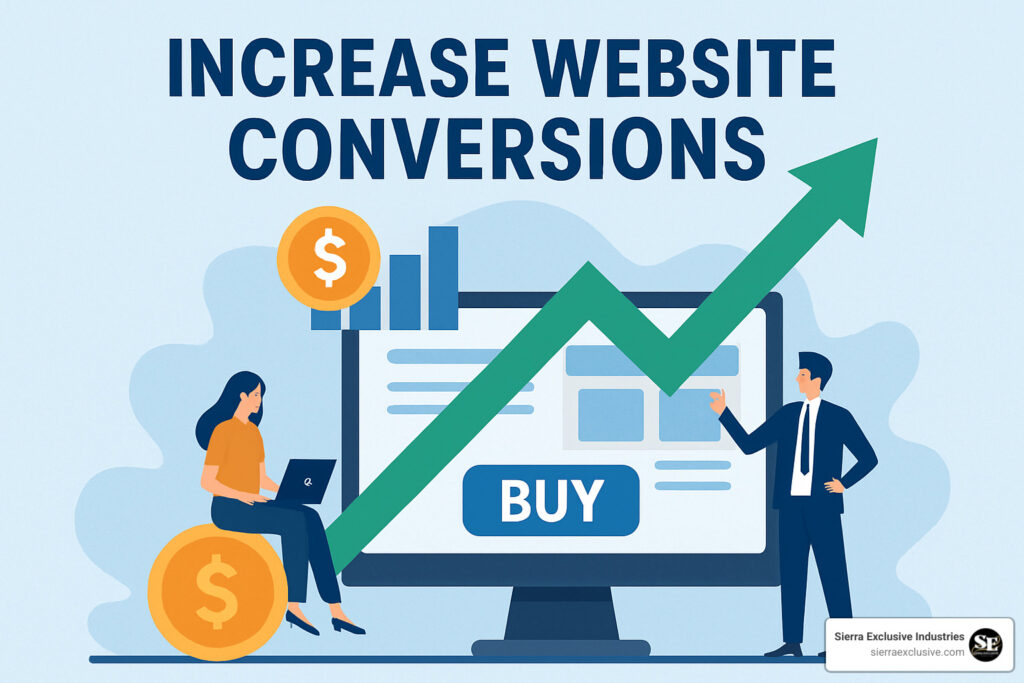To increase website conversions, focus on these proven strategies:
- Craft a clear value proposition that speaks directly to your audience
- Optimize page speed to under 3 seconds (40% of users abandon slower sites)
- Simplify forms and checkout by reducing fields to essentials only
- Add trust signals like security badges and customer reviews
- Implement A/B testing on headlines, CTAs, and page layouts
- Use personalization to deliver relevant content to each visitor segment
Here’s the reality: 96% of website visitors leave without converting. That means for every 100 people who visit your site, only 2-4 actually take the action you want them to take.
The top 10% of websites achieve conversion rates of 11.45% or higher. The difference isn’t luck. It’s strategy.
The average e-commerce conversion rate hovers around 2.5-3% across industries. Yet companies using data-driven optimization see 8-10% profit increases and 10% cost reductions. That’s the power of focusing on conversions instead of just traffic.
In 2025, simply driving more visitors to your website isn’t enough. With rising ad costs and increased competition, you need every visitor to count. The businesses that win will be those that master the art and science of conversion optimization.
I’m Seth Gillen, and I’ve spent over 10 years helping companies scale to $10M+ in annual revenue by implementing proven strategies to increase website conversions. Through my work with Sierra Exclusive Marketing, I’ve seen how the right conversion tactics can transform struggling websites into revenue-generating machines.
What Counts as a Conversion & Why It Matters
Most businesses are tracking conversions all wrong. They focus only on the big moments – purchases, phone calls, signed contracts – while ignoring the smaller actions that actually predict success.
A conversion is simply when someone takes an action you want them to take. But there are two different types, and understanding the difference is crucial if you want to increase website conversions.
Macro conversions are your money makers: purchases, lead forms, phone calls, demo bookings, or account registrations.
Micro conversions are the stepping stones: downloading guides, watching videos, newsletter signups, or adding items to cart.
Here’s why this matters:research shows that understanding the relationship between these conversion types is essential for building strategies that actually work. Your customer journey isn’t a straight line from stranger to buyer. It’s more like climbing a ladder, where each micro conversion gets them closer to the top.
Types of Conversions You Should Track
Primary actions are your bread and butter conversions: purchase completions, lead form submissions, phone calls generated from your website, demo or consultation bookings, and account registrations.
Secondary actions reveal buying intent: newsletter signups, content downloads, video engagement (50%+ watched), product page views, and cart additions.
Engagement signals help identify promising visitors: meaningful time on site (2+ minutes), multiple page visits, social media interactions, live chat initiations, and return visits within 30 days.
Here’s the game-changing insight: visitors who complete micro conversions are 3-5 times more likely to eventually complete your macro conversions. That newsletter signup might seem small, but it’s actually a powerful predictor of future sales.
Core Metrics & Benchmarks You Must Know
The math behind conversions is simple: Conversion Rate = (Number of Conversions ÷ Total Visitors) × 100
Say 50 people out of 2,000 visitors take your desired action. That gives you a 2.5% conversion rate.
The average conversion rate across all industries sits at 2.35%. Top 25% of websites achieve 5.31% or higher. The top 10% of websites hit 11.45% or higher – nearly five times the average.
For e-commerce specifically, most sites hover around 2.5-3%. If you’re below this range, you’re literally watching money walk away.
Even small improvements can create massive results.
Your industry makes a huge difference. Arts & Crafts businesses typically see 3.84-4.07% conversion rates, while Health & Wellness ranges from 1.87-4.20%. Consumer Electronics faces tough competition with rates under 1.5%.
Traffic source matters too. Referral traffic converts at 5.44% because it comes with built-in trust. Organic search closes at 14.6% compared to just 1.7% for paid traffic.
Diagnostic KPIs Beyond Conversion Rate
Bounce rate measures single-page visits. When bounce rates climb above 70%, you’ve got a messaging problem.
Exit rate shows where people give up. If 80% of people leave your checkout page, you know exactly where to focus.
Average session duration reveals engagement levels. Sessions under 30 seconds rarely convert because people need time to build trust.
Cart abandonment rate hits e-commerce hard at an average of 69.23%. Every percentage point you recover here goes straight to your bottom line.
14 Proven Tactics to Increase Website Conversions Fast
These are the exact strategies I’ve used to help businesses across Sacramento, Roseville, and throughout California increase website conversions by 200-400%.
Craft a Magnetic Value Proposition
Your value proposition is like the first impression at a job interview – you get one shot to make it count.
The best value propositions answer three questions within 10 seconds: What do you offer?How does it solve my problem?Why should I choose you?
Can you explain your core benefit in 10 words or less? If not, your message is too complex.
Focus on benefits over features every time. Instead of “Advanced CRM software with 50+ integrations,” try “Close 30% more deals with automated follow-up.”
The science behind value propositions shows they can make or break your conversion rate. I’ve seen a simple headline change increase conversions by 34% – just by switching from features to benefits.
Optimize Above-the-Fold Content
The area above the fold gets 80% of your visitor’s attention.
Your visual hierarchy should guide eyes naturally to your most important elements. Position your main CTA in the upper right quadrant where eyes naturally land.
Your hero images should support your message, not compete with it. If you use photos of people, make sure they’re looking toward your CTA.
Ensure messaging match between your ads and landing pages. Mismatched messaging is like promising pizza and serving salad.
Speed First: Sub-3-Second Page Loads
Page speed is a conversion killer.53% of mobile visitors abandon pages that take longer than 3 seconds to load.
Every additional second reduces conversions by 7%. For a business doing $100,000 monthly online, that’s $7,000 lost per month per second.
Compress your images to under 100KB, use a CDN, enable browser caching, and minimize JavaScript/CSS files.
I helped a Folsom client reduce load time from 6 seconds to 2.1 seconds. Their conversion rate jumped from 1.8% to 3.2% – adding $89,000 in monthly revenue.
Mobile-First, Always Responsive
With mobile traffic at nearly 50% of all visits, mobile optimization is survival.
Thumb zones matter. Place important buttons within easy thumb reach – the bottom third of the screen.
Your mobile checkout should be frictionless. Offer guest checkout, Apple Pay/Google Pay, and auto-fill capabilities.
Simplify Forms & Checkout
A major e-commerce site removed one field from checkout – the requirement to create an account. That single change generated $300 million in additional annual revenue.
Ask for only essential information. Every additional field reduces conversions. Use multi-step forms – they convert 86% better than overwhelming single-step forms.
Add progress bars and enable guest checkout because 37% of shoppers abandon when forced to register.
I reduced a client’s form from 9 fields to 4 and watched conversions increase from 2.1% to 4.7%.
Use Trust Signals to Increase Website Conversions
Trust is the invisible foundation of every conversion.
SSL certificates and security badges should be prominent. Money-back guarantees work well. Customer testimonials with photos and full names carry more weight than anonymous reviews.
Display industry certifications, include your physical address and phone number, and showcase media mentions.
Personalization & Segmentation to Increase Website Conversions
Generic websites get generic results. Personalized experiences get premium conversions.
Dynamic content based on visitor behavior, location, or traffic source dramatically improves relevance. Show different headlines to first-time versus returning visitors.
Personalized CTAs perform 202% better than basic versions.Our AI-powered marketing solutions help businesses automatically personalize content, increasing conversions by an average of 47%.
A/B Test High-Impact Elements
A/B testing removes guesswork from optimization.
Headlines can impact conversions by 30% or more. CTA button color and text often surprise with their impact. Page layout changes can dramatically affect behavior.
Test one element at a time for clear results. One client saw 104% conversion increase just by changing their CTA from “Submit” to “Get My Free Quote.”
Leverage Social Proof & Reviews
Social proof is psychological gold for conversions.
Customer reviews and ratings build credibility. User-generated content shows real people using your products. Case studies provide detailed proof of results.
Visitors who interact with reviews are 58% more likely to convert.
Implement Live Chat & Chatbots
Live chat can increase website conversions by up to 20% by providing real-time answers.
Set up proactive messages within 30 seconds on high-intent pages. 69% of consumers prefer chatbots for quick answers to simple questions.
Recover Lost Sales with Cart-Abandonment Flows
With cart abandonment exceeding 69%, recovery campaigns are essential.
Send an immediate email within 1 hour, follow up with a reminder 24 hours later, and send an incentive after 72 hours.
Create Urgency with Scarcity & Limited-Time Offers
Urgency triggers fear of missing out when used authentically.
Countdown timers for genuine deadlines, limited stock notifications, and seasonal promotions drive action. Only use real scarcity – fake urgency destroys credibility.
Fine-Tune On-Site Search & Navigation
69% of shoppers go straight to search, and 80% leave after bad search experiences.
Your search needs auto-complete, spell-check, visual results, and filter options. Navigation should allow finding anything within 3 clicks.
Measure, Learn, Repeat (Analytics & Heatmaps)
You can’t optimize what you don’t measure.
Use Google Analytics 4 for conversion tracking, heatmap tools like Hotjar for behavior analysis, and session recordings to watch user interactions.
Diagnosing Friction with Funnel & Behavior Analysis
Think of your website like a leaky bucket. Traffic flows in at the top, but conversions drip out at the bottom. The question is: where are the holes?
Confusing navigation is the #1 culprit. When visitors can’t figure out their next step, they bounce. Slow page load times cost you 7% of conversions per second of delay.
Complicated forms make people give up. We watched session recordings of a client’s 12-field contact form. The average person filled out 7 fields, paused, then closed the tab.
Poor mobile experience shows up clearly in behavior data. You’ll see visitors zooming in, struggling to tap buttons, or abandoning checkout.
Mismatched expectations from ads to landing pages create immediate friction. If your ad promises “free shipping” but your landing page doesn’t mention it, visitors feel deceived.
Understanding exit rates is crucial. Pages with exit rates above 70% indicate something’s broken.
Scroll depth tracking tells an important story. If 80% never scroll past your hero section, your compelling content is invisible.
Session replays let you watch over someone’s shoulder as they steer your site. We’ve seen visitors click broken buttons five times or abandon carts because they couldn’t find security badges.
Tools & Methods for Insight
Dynamic heatmaps show exactly where people click, scroll, and hover. They reveal “ghost clicks” – areas where visitors try to click but nothing happens.
On-site surveys give you the “why” behind behavior. Questions like “What’s preventing you from completing your purchase?” provide direct feedback.
Cohort analysis tracks visitor groups over time to reveal patterns. You might find social media visitors convert better on their third visit, while email subscribers convert immediately.
Combining these methods creates a complete picture of your conversion obstacles and opportunities.
Frequently Asked Questions About Increasing Website Conversions
What is considered a “good” website conversion rate?
What counts as “good” depends on your industry and business model.
Most websites hover around 2-3% – that’s your baseline. 3-5% means you’re doing better than average. 5% or higher puts you in the top 25%. 10% or higher means you’re in elite company – the top 10%.
Even tiny improvements create massive results. Moving from 2% to 3% is actually a 50% increase in conversions.
How is conversion rate calculated?
Conversion Rate = (Number of Conversions ÷ Total Visitors) × 100
If 50 people filled out your contact form from 2,000 visitors, your conversion rate is 2.5%.
Track this monthly and break it down by traffic source. You might find email converts at 4% while social media only converts at 1%.
Why do visitors fail to convert even with high traffic?
The most common culprit is an unclear value proposition. Visitors can’t figure out what you’re offering or why they should care within 5 seconds.
Slow page speeds kill conversions – 53% of mobile visitors abandon pages taking longer than 3 seconds.
Lack of trust signals like reviews, security badges, or guarantees makes visitors nervous.
Complicated forms and checkout create unnecessary friction. We’ve seen 100% conversion increases just by reducing contact forms from 8 fields to 3.
Poor mobile experience loses nearly half your potential conversions.
Mismatched messaging between ads and landing pages confuses visitors and makes them feel tricked.
Conclusion
After helping hundreds of businesses increase website conversions, I’ve learned that winners aren’t those with the biggest budgets or flashiest websites. They’re the ones that understand their visitors and systematically remove conversion barriers.
Start with the foundation: fix your page speed, nail your mobile experience, and craft a value proposition that makes visitors say “yes, this is exactly what I need.”
Once those fundamentals are solid, add trust signals and social proof. Then move into advanced strategies like personalization and behavioral analysis.
The top 10% of websites achieve conversion rates of 11.45% or higher. The difference isn’t magic – it’s continuous optimization based on real data, not gut feelings.
Every month you delay optimization is money left on the table. If your site gets 5,000 visitors monthly and you improve from 2% to 4% conversions, that’s 100 additional conversions every month.
At Sierra Exclusive Marketing, we’ve seen this change dozens of times. A Sacramento restaurant chain increased online orders by 340% in six months. A Roseville software company went from 1.8% to 6.2% conversions using our AI-powered optimization approach.
What makes our approach different: we guarantee results or you don’t pay. We focus on the numbers that matter to your bottom line – more conversions, more customers, more revenue.
Our full-service digital marketing solutions combine everything in this guide with ongoing optimization and support. Conversion optimization isn’t a one-time project – it’s an ongoing process of testing, learning, and improving.
While your competitors spend more money driving traffic, you can focus on converting the visitors you already have. In 2025, that’s not just a competitive advantage – it’s the difference between businesses that thrive and those that merely survive.
Your website visitors are telling you exactly what they need through their behavior. The question is: are you listening, and are you acting on what they’re telling you?





